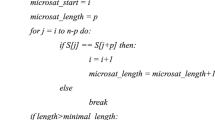Abstract.
Microsatellite length variation was investigated at a highly variable microsatellite locus in four species of Apodemus. Information obtained from microsatellite allele sequences was contrasted with allele sizes, which included 18 electromorphs. Additional analysis of a 400-bp unique sequence in the flanking region identified 26 different haplotype sequences or ``true'' alleles in the sample. Three molecular mechanisms, namely, (1) addition/deletion of repeats, (2) substitutions and indels in the flanking region, and (3) mutations interrupting the repeat, contributed to the generation of allelic variation. Size homoplasy can be inferred for alleles within populations, from different populations of the same species, and from different species. We propose that microsatellite flanking sequences may be informative markers for investigating mutation processes in microsatellite repeats as well as phylogenetic relationships among alleles, populations, and species.
Similar content being viewed by others
Author information
Authors and Affiliations
Additional information
Received: 3 November 1999 / Accepted: 2 May 2000
Rights and permissions
About this article
Cite this article
Makova, K., Nekrutenko, A. & Baker, R. Evolution of Microsatellite Alleles in Four Species of Mice (Genus Apodemus). J Mol Evol 51, 166–172 (2000). https://doi.org/10.1007/s002390010077
Published:
Issue Date:
DOI: https://doi.org/10.1007/s002390010077



